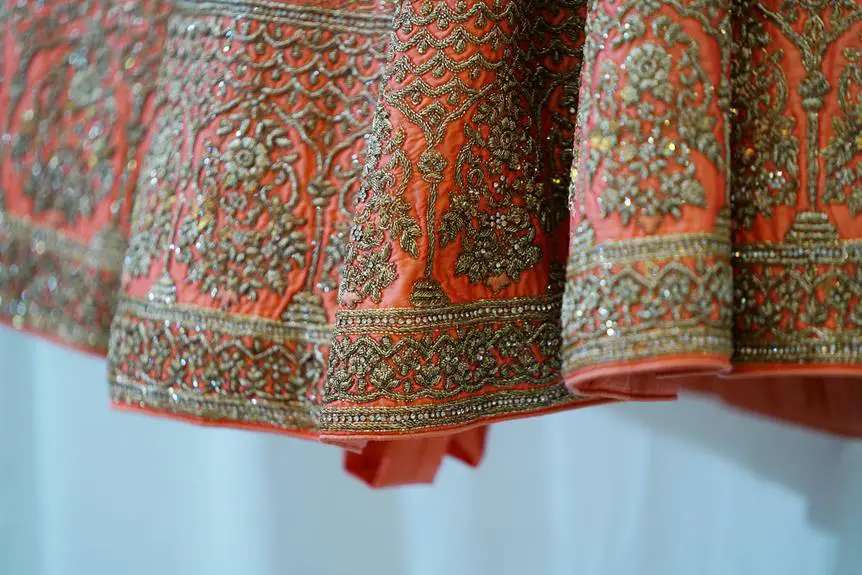Hey there, diving into the cost of making a dress is like peeling back the layers of an onion. It's a fascinating journey where every layer reveals a new aspect of the dressmaking process.
From fabric expenses to notions and accessories, understanding the true cost is crucial for mastery in dressmaking.
In this guide, we'll explore the intricacies of fabric costs, the often-overlooked expenses, and the impact of design complexity on your budget.
By the end, you'll have a comprehensive understanding of the true cost of making a dress, equipping you with the knowledge to approach your next project with confidence and clarity.
Let's get started!
Key Takeaways
- The type of fabric chosen is a significant factor in determining the cost of making a dress.
- Conducting a cost analysis and considering the amount of fabric needed are important steps in selecting fabric.
- Being resourceful and creative in sourcing materials can help save costs.
- Design complexity and intricate designs often result in higher production costs.
Understanding Fabric Costs
How much does it actually cost to purchase the fabric needed to make a dress?
When it comes to fabric selection and cost analysis for making a dress, it's essential to consider various factors that will impact the overall expenses.
The type of fabric you choose plays a significant role in determining the cost of making a dress. Fabrics come in a wide range of prices, from affordable options like cotton and polyester to more luxurious choices such as silk and satin. Understanding the cost implications of different fabrics is crucial in managing your budget effectively.
Before diving into fabric selection, it's important to conduct a thorough cost analysis. Consider the amount of fabric required for the dress pattern, the cost per yard, and any additional materials needed for the project. This meticulous approach will help you make informed decisions about the fabric that align with your budget and design goals.
Notions and Accessories Expenses
Calculate the cost of zippers, buttons, and other notions you'll need to complete your dress, ensuring you account for all accessories in your budget.
Sourcing materials for these notions and accessories can be an enjoyable part of the dressmaking process, as it allows you to add unique touches to your creation. When sourcing materials, consider visiting local fabric stores, checking online suppliers, or repurposing items from old garments. This can help you find the best quality items at the most affordable prices.
Additionally, consider cost-saving techniques such as buying in bulk or looking for sales and discounts to reduce expenses without compromising on quality. You can also explore using alternative notions and accessories, such as fabric-covered buttons instead of more expensive options, to stay within your budget.
Being resourceful and creative in sourcing and selecting notions and accessories can elevate your dressmaking skills and result in a stunning garment while keeping costs in check.
Labor and Time Investment
When considering the cost of making a dress, you should also account for the time and effort involved in the labor, as this will impact the overall expenses of your project. The time commitment and labor costs play a significant role in determining the total cost of producing a dress.
Here's what you need to consider:
- Time Commitment: The production process for a dress demands a considerable amount of time. From pattern making to cutting, sewing, and finishing, each step requires dedicated hours of work.
- Skill Level: Your expertise in dressmaking affects the time needed for each task. Beginners may take longer to complete a dress, while experienced sewers can work more efficiently.
- Labor Costs: If you're hiring someone to help with the production process, you must consider the associated labor costs, which can significantly impact your overall expenses.
- Production Process: Understanding the intricacies of the production process is crucial. It involves organizing the workflow, managing different tasks, and ensuring a high-quality end product.
Considering these factors will help you gauge the true cost of making a dress, allowing you to plan and budget effectively.
Hidden Costs to Consider
Consider additional expenses such as embellishments, closures, and specialized tools when calculating the total cost of making a dress. These unforeseen expenses can significantly impact your budget if not carefully considered.
Embellishments like beads, sequins, or lace can add elegance to your dress but also come with a cost. Similarly, closures such as zippers, buttons, or hooks, and specialized tools like sewing machine needles, thread, and pressing tools are often overlooked but essential for the completion of your garment.
To mitigate these hidden costs, consider cost-saving strategies such as buying embellishments and closures in bulk or during sales, using coupons for specialized tools, and repurposing items from old clothing or accessories.
Additionally, carefully planning your design and choosing simpler closures or embellishments can also help reduce these unforeseen expenses.
Budgeting for Dress Patterns
So, you've got your fabric costs all sorted out, but what about the pattern?
When budgeting for dress patterns, it's important to consider the various costs involved in purchasing or acquiring them.
From commercial patterns to free online options, there are budget-friendly choices to suit your needs without compromising on style or fit.
Pattern Cost Considerations
Budgeting for dress patterns requires careful consideration of the cost and variety of available options. When planning your pattern expenses, keep in mind the following factors:
- Pattern Complexity: Choose patterns that align with your skill level to avoid frustration and potential mistakes.
- Fitting Adjustments: Consider the need for alterations to achieve the perfect fit, especially if you have unique body proportions.
- Pattern Reusability: Opt for patterns that offer multiple dress styles or variations to maximize their value.
- Pattern Sales and Discounts: Keep an eye out for sales, promotions, or bundle deals to save money on your pattern purchases.
Budget-Friendly Pattern Options
When planning your dress patterns budget, prioritize seeking out affordable options that align with your sewing skill level and offer versatility. Look for affordable designs that can be used for various dress styles, such as shift dresses, maxi dresses, or wrap dresses.
There are many budget-friendly pattern alternatives available, including downloadable PDF patterns, which often cost less than printed patterns and can be printed at home. Additionally, consider multi-size patterns that offer different sizing options in one package, allowing you to use the pattern for multiple projects.
Another cost-effective option is to look for free patterns online, especially from reputable sources or sewing communities. By exploring these affordable pattern options, you can maintain your budget while still accessing a wide range of design choices for your dressmaking projects.
Impact of Design Complexity
Hey there!
When it comes to the cost of making a dress, the design complexity can have a big impact on your expenses. If you're looking to save some money, simplifying the design can be a great way to cut down on costs without sacrificing style.
Let's take a closer look at how the intricacy of your dress design affects your budget.
Design Affects Cost
Considering the intricacy of the design directly influences the cost of making a dress. The more intricate the design, the higher the cost of production. Here's how design complexity affects the cost:
- Intricate designs require more time and skill to execute, increasing labor costs.
- Complex patterns may result in more fabric wastage, leading to higher material expenses.
- Specialized techniques, such as hand embroidery or intricate embellishments, add to the overall cost.
- Design complexity can also impact the production timeline, potentially affecting overhead costs.
When considering design complexity, it's essential to balance creativity with cost-saving techniques. Simplifying certain design elements or opting for alternative materials could help manage expenses without compromising the overall aesthetic appeal.
Simplify for Savings
To simplify for savings and minimize production costs, your design's intricacy must be carefully evaluated and potentially modified. Cost-saving techniques can be applied by simplifying complex design elements that require intricate construction. Consider using fabric alternatives that are more cost-effective without compromising the overall look and feel of the dress.
Simplifying the design can reduce the amount of fabric needed, which in turn lowers material costs. Streamlining the construction process by minimizing intricate details also saves on labor expenses. By simplifying the design, you can achieve a more cost-effective production process without sacrificing the quality or aesthetic appeal of the dress.
Careful consideration of each design element and its impact on production costs is essential for creating a beautiful dress while staying within budget.
Tips for Cost-Effective Dressmaking
To make your dressmaking more cost-effective, focus on finding budget-friendly fabric options and utilizing your existing sewing supplies efficiently. Here are some tips to help you save money while creating beautiful garments:
- Material sourcing: Look for sales, discounts, and bulk deals when purchasing fabric. Consider using alternative materials such as thrifted clothing, bedsheets, or curtains for your dressmaking projects. You can also explore online fabric marketplaces or local fabric stores for affordable options.
- Cost saving techniques: Make the most of your patterns by maximizing the use of fabric and minimizing waste. Consider creating muslin prototypes to perfect the fit before cutting into your final fabric. Additionally, explore the possibility of repurposing old garments or using remnants for smaller dressmaking projects.
- Efficient use of sewing supplies: Take inventory of your sewing tools and supplies to avoid unnecessary purchases. Reuse zippers, buttons, and trims from old clothing or thrifted items. Keeping your sewing area organized will help you easily locate what you need, saving time and money.
Frequently Asked Questions
How Do I Calculate the Cost of Making a Dress if I Want to Use a Specific Designer Fabric?
First, calculate the cost of the designer fabric by multiplying the price per yard by the required yardage. Add other expenses like thread and zippers. Budgeting patterns and sourcing materials can help manage costs effectively.
Are There Any Additional Expenses I Should Consider When Purchasing Notions and Accessories for Dressmaking?
When planning your dressmaking budget, be sure to consider notions and accessories. Smart dressmaking budgeting techniques include researching prices, prioritizing essentials, and being mindful of quality. These factors will help you stay within your budget.
What Is the Average Time Investment for Making a Dress From Start to Finish?
When making a dress, the average time investment from start to finish depends on the complexity of the design process, your time management, and dressmaking techniques. It's important to plan and execute efficiently.
Are There Any Unexpected Hidden Costs That I Should Be Aware of When Making a Dress?
When making a dress, be aware of hidden costs like fabric quality and unexpected expenses such as designer fees. Paying attention to these factors can help you avoid surprises and stay within your budget.
How Can I Budget for the Cost of Dress Patterns When Making My Own Dress?
When making your own dress, consider budgeting tips for dress patterns. Look for free options or sales. Invest in versatile patterns to maximize use. Swap fabric options with friends to save money and explore variety.
- How Does Ring Spun Cotton Affect Garment Fit and Shape Retention? - August 13, 2024
- What Are the Challenges in Producing Ring Spun Cotton? - August 13, 2024
- Is Ring Spun Cotton Suitable for Plus-Size Clothing? - August 13, 2024





